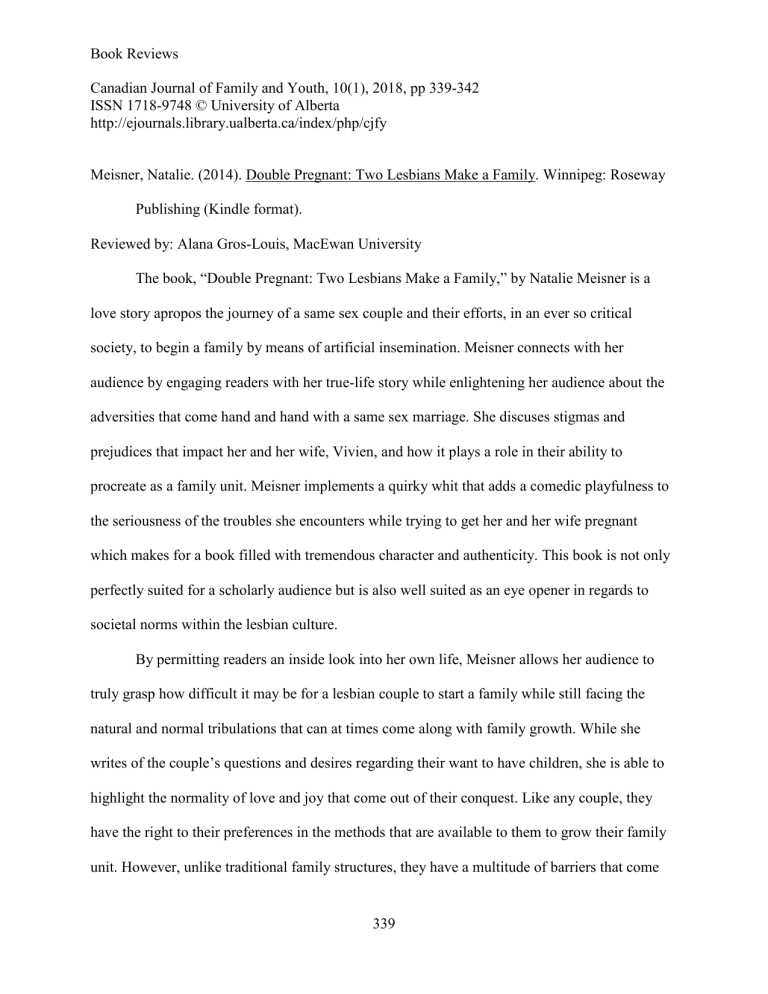
Book Reviews Canadian Journal of Family and Youth, 10(1), 2018, pp 339-342 ISSN 1718-9748 © University of Alberta http://ejournals.library.ualberta.ca/index/php/cjfy Meisner, Natalie. (2014). Double Pregnant: Two Lesbians Make a Family. Winnipeg: Roseway Publishing (Kindle format). Reviewed by: Alana Gros-Louis, MacEwan University The book, “Double Pregnant: Two Lesbians Make a Family,” by Natalie Meisner is a love story apropos the journey of a same sex couple and their efforts, in an ever so critical society, to begin a family by means of artificial insemination. Meisner connects with her audience by engaging readers with her true-life story while enlightening her audience about the adversities that come hand and hand with a same sex marriage. She discuses stigmas and prejudices that impact her and her wife, Vivien, and how it plays a role in their ability to procreate as a family unit. Meisner implements a quirky whit that adds a comedic playfulness to the seriousness of the troubles she encounters while trying to get her and her wife pregnant which makes for a book filled with tremendous character and authenticity. This book is not only perfectly suited for a scholarly audience but is also well suited as an eye opener in regards to societal norms within the lesbian culture. By permitting readers an inside look into her own life, Meisner allows her audience to truly grasp how difficult it may be for a lesbian couple to start a family while still facing the natural and normal tribulations that can at times come along with family growth. While she writes of the couple’s questions and desires regarding their want to have children, she is able to highlight the normality of love and joy that come out of their conquest. Like any couple, they have the right to their preferences in the methods that are available to them to grow their family unit. However, unlike traditional family structures, they have a multitude of barriers that come 339 Book Reviews on top of the already difficult journey of expanding a family. Together, they face the struggle and complications with the health of their eggs due to their age, the obstacles that can be present for biracial couples including the effects of racism that their children may have to endure, and they must ultimately find a sperm donor who is willing to comply with their ideal family structure. Meisner and her wife slowly come to realize that because they are not the traditional family, they must let go of some of their desires and previously thought through plans for their pregnancy. Their end result of how they create a family seems to be almost the complete opposite of their original plans. This has the ability to open the minds of readers and truly show the amount that a same sex couple has to sacrifice in order to start a family in regards to who the donor may be and their involvement in the child’s life, where they geographically may start a same sex family in terms of legality, and how their children will ultimately be raised. Meisner is quite informative in the sense that even individuals who are open-minded, accepting, and knowledgeable of the lesbian culture, may not truly know how much adversity is faced during the building of a family; the book is written in a fashion that gives sight into documented real life experiences and because of this, it touches upon facts that may not necessarily be included in theoretical based literature. To explore the ideas of stigmas against the lesbian society, Meisner explains the diversity of reactions and predispositions that are held amongst individuals across the world. Not only does she account her experiences in regards to how society effects her journey to create a family within Canada but she also explores international thoughts on the topic of same sex marriage and reproduction. Meisner describes her and Vivien’s journey coast to coast in Canada and how province to province expectations of a lesbian family shift. While the duo experience less of acceptance on the east coast of Canada, the population on the west coast seems to, in general, 340 Book Reviews have more of an open mind in terms of same sex relationships. This shows the geographical influence in the values of a society. However, Meisner does reflect on the distinction between state law and societal norms as she states: “There might be a gayby boom, but it only stretches over the parts of the earth that have legal rights and protections for gay people, and that is still a relatively small piece of the globe” (p. 2614). While Meisner uses humour to refer to gay couples having children throughout the world, her point is quite sad. Although growing a family and having children as lesbians is proven to have complications in Canada, the point is made that there are other nations, where it may not even be a possibility. This highlights cross culture opinions on gay society and it brings forth the idea that many gay individuals throughout the world do not have the right to love their choice of a partner, let alone create a family. This concept is one that brings forth civil rights movements and creates change throughout the world; the change is slow but it is a change nonetheless. This would have been an excellent topic to expand upon in her book as the impact varies through diverse cultures and the outcomes of life as a lesbian differ tremendously between woman to woman. To find a donor, the Albertan based couple must constantly relocate in order to meet potential men. The complexity of relocating is shown to be more than one may expect as both women only have a very short window of fertility that may come at unexpecting times. The women must drop everything, including jobs and responsibilities in order to meet these men all over Canada. The women sometimes drive province to province at a moment’s notice and their utter existence revolves around their desire to start a family. This concept of relocation for a mere chance at finding a donor demonstrates the struggles that lesbian couples face in not only having a family that goes against the traditional norms but in starting one. The idea that these women are willing to tackle every obstacle in their way shows just how devoted and committed 341 Book Reviews they are to starting a family and it counters the possible argument that lesbians are not able to commit to potential children. Meisner’s personal experience with her wife in travelling across Canada and meeting with many different types of men demonstrate their willingness to do just that. Although Meisner’s book was written as a comical and light read, her ideas and life events are able to be taken seriously. Her text could be considered for scholarly purposes in areas such as woman’s studies, LGBTQ studies, sociology, history, and many more. While she does not use theoretical aspects to convey her ideas and opinions, she is able to attract her audience and maintain their attention by relating to her personal events and her human endeavors. While sharing her life story with the public gives way for criticism and negative opinions of strangers, Meisner opens up the possibility for her audience to create new and informed opinions about the lesbian community while sympathizing with her on a personal level as well. I wonder however, if because of her light-hearted approach to her book, scholarly readers may discredit her ideas and stance on lesbian rights due to the fact that her text is of subjective nature. Even so, her effort in sharing her personal story in attempts to inform and educate her audience is admirable and her book has the ability to create a small change in consideration to a large movement. 342
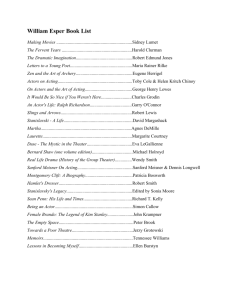
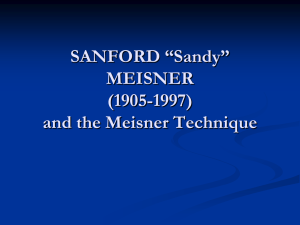
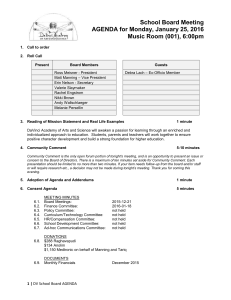
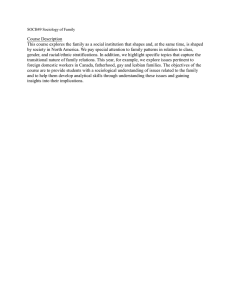
![-----Original Message----- [mailto:] Sent: Monday, March 14, 2005 1:40 PM](http://s2.studylib.net/store/data/015588373_1-7bff81458ec3f7ba2c91b69016705723-300x300.png)
